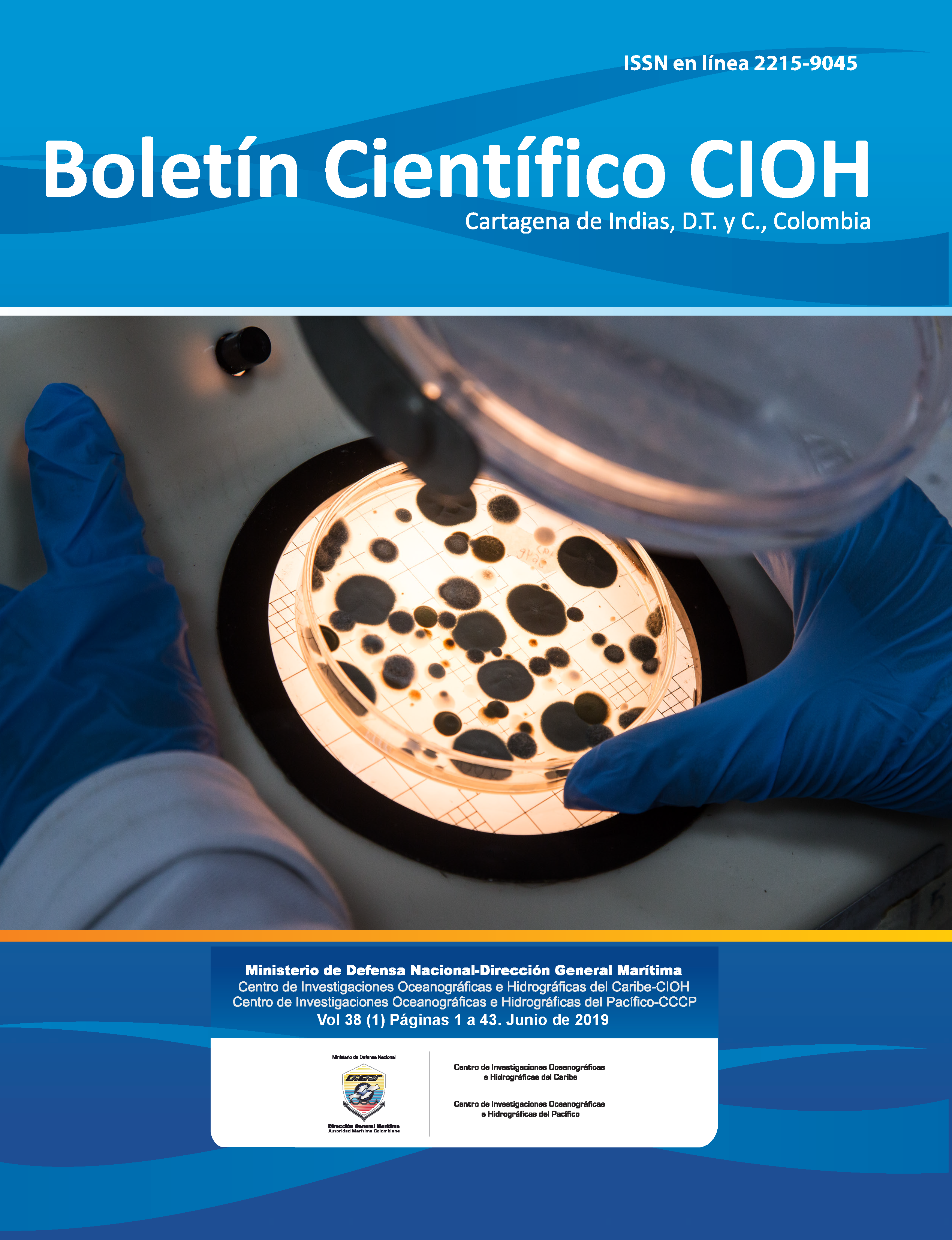NEW RECORD OF Cladopyxis hemibrachiata SPECIES OF THE DINOFLAGENATE GROUP FOR THE SEAFLOWER BIOSPHERE RESERVE, COLOMBIAN CARIBBEAN
DOI:
https://doi.org/10.26640/22159045.2019.466Abstract
Dinoflagellates are considered as a very diverse group founded in most aquatic environments, however, despite the importance of this group, there are few works on them in the Caribbean Sea area, being the nearest in the Gulf of Mexico and the Vitória-Trindade submarine chain in Brazil. Hereby, Cladopyxis hemibrachiata is reported for first time in the Colombian Caribbean Sea, particularly found in the Seaflower Biosphere Reserve waters. The identification reports were part of an expedition carried out in September 2017 on Cayo Serranilla Island. Phytoplankton samples were collected by vertical drags from 200 m. deep using a 20 µm and 70 cm ring diameter conical net. In situ physical and chemical measured variables were typical of mesotrophic waters. As part of the confirmatory process of this new report for the Colombian Caribbean Sea, all aspects that many researchers have identified as fundamental to avoid mistakes in the identification of specimens, which are associated with the great similarity with Cladophyxis brachiolata were considered.
Downloads
References
Balech, E. (1964). El género "Cladopyxis" (Dinoflagellata). Museo Argentino de ciencias naturales Bernardino Rivadavia e Instituto nacional de investigación de las ciencias naturales. Comunicaciones. Hidrobiología, 1(4), 27-39.
Balech, E. (1967). Dinoflagellates and tintinnids in the northeastern Gulf of Mexico. Bulletin of Marine Science, 17(2), 280-298.
Guiry, M. & Guiry, G. AlgaeBase. World-wide electronic publication, National University of Ireland, Galway. 2018 URL:_http://www.algaebase.org. Consultado el 02 October 2019.
Gómez, F. (2012). A quantitative review of the lifestyle, habitat and trophic diversity of dinoflagellates (Dinoflagellata, Alveolata). Systematics and Biodiversity, 10(3), 267-275.
González, L., Pacheco, J., Mazzeo, N., Levrini, P., Clemente, J., Lagomarsino, J. & Fosalba, C. (2017). Factores ambientales controladores del fitoplancton con énfasis en las cianobacterias potencialmente tóxicas en un lago somero utilizado como fuente de agua para potabilización: Laguna del Sauce, Maldonado, Uruguay. Revista del laboratorio tecnológico del Uruguay, 13, 26 – 35.
Licea, S., Zamudio, M., Luna, R. & Soto, J. (2004). Free-living dinoflagellates in the southern Gulf of Mexico: report of data (1979–2002). Phycological Research, 52: 419–428.
Lopez, J. (2011). Trascendencia e importancia para una población de ciertas representaciones gráficas, encontradas durante un viaje a la Isla de San Andrés, Colombia. Reserva mundial de biosfera por la UNESCO. Revista zona publicación semestral, 10, 20-33.
Lozano, Y., Vidal, L. & Navas, G. (2011). Lista de especies de dinoflagelados (Dinophyta) registrados en el mar Caribe Colombiano. Boletín de Investigaciones Marinas y Costeras, 40 (2): 361-380.
Lubiana, K. & Dias, C. (2016). The composition and new records of micro and mesophytoplankton near the Vitória-Trindade Seamount Chain. Rev. Biota Neotropica, 16(3).
Steidinger K., Faust, M. & Hernández-Becerril, D. (2009). Dinoflagellates (Dinoflagellata) of the Gulf of Mexico. En: Felder D. & Camp D. (eds.). Gulf of Mexico–Origins, Waters, and Biota. Vol. 1: Biodiversity. Texas A&M University Press.; College Station, Texas.
Taylor, F., Hoppenrath, M. & Saldarriaga, J. (2008). Dinoflagellate diversity and distribution. Biodivers. Conserv., 17, 407-418.
Vargas, J. (2008). Distribución horizontal y vertical de la comunidad fitoplanctónica, alrededor de las islas de Providencia y Santa Catalina, Caribe Colombiano (Época húmeda de 2005). Tesis de pregrado. Universidad Jorge Tadeo Lozano. Bogotá.
Wood, E. (1968). Dinoflagellates of the Caribbean sea and adjacent areas. Univ. Miami; 143 pp
Downloads
Published
Issue
Section
License
Copyright (c) 2019 Boletín Científico CIOH

This work is licensed under a Creative Commons Attribution-NonCommercial-NoDerivatives 4.0 International License.
Attribution — You must give appropriate credit, provide a link to the license, and indicate if changes were made. You may do so in any reasonable manner, but not in any way that suggests the licensor endorses you or your use.
NonCommercial — You may not use the material for commercial purposes.
NoDerivatives — If you remix, transform, or build upon the material, you may not distribute the modified material.
No additional restrictions — You may not apply legal terms or technological measures that legally restrict others from doing anything the license permits.



